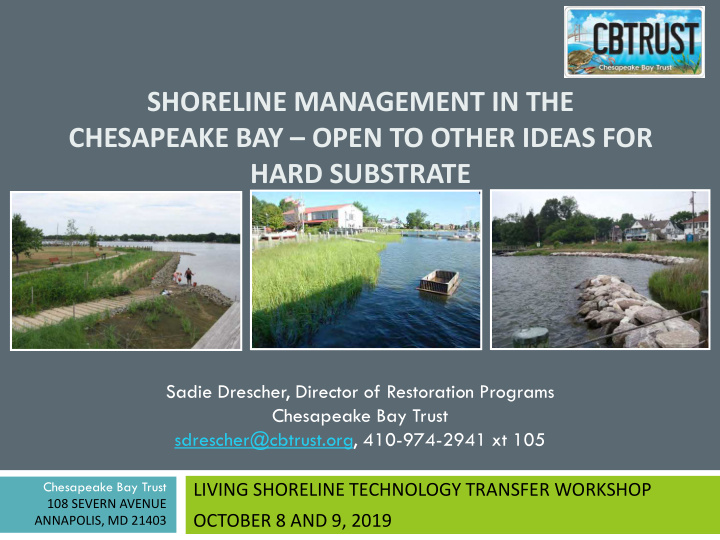



SHORELINE MANAGEMENT IN THE CHESAPEAKE BAY – OPEN TO OTHER IDEAS FOR HARD SUBSTRATE Sadie Drescher, Director of Restoration Programs Chesapeake Bay Trust sdrescher@cbtrust.org, 410-974-2941 xt 105 Chesapeake Bay Trust LIVING SHORELINE TECHNOLOGY TRANSFER WORKSHOP 108 SEVERN AVENUE OCTOBER 8 AND 9, 2019 ANNAPOLIS, MD 21403
Living Shorelines defined as “Shoreline Management” A continuum of shoreline management practices that is based on the amount of hard shore armor structure used.
Shoreline Management has TN, TP, and TSS load reduction credits in the Chesapeake Bay Shoreline Management expert panel developed load reductions for prevented sediment, denitrification, sedimentation, redfield ratio, and default values Sediment reduction credit tied to tidal erosion rate and can be quite high Minority dissenting view for prevented sediment – coarse sand is good for SAV and habitat Qualifying conditions to attain “credits” Credits conservative based on science available Credits limited to 5 years; need re-inspection Panel report should update every 2 years – but has not been done yet
Shoreline Management Developed load reductions for prevented sediment, denitrification, sedimentation, and redfield ratio plus default value Qualifying conditions Credits conservative based on science available Sediment reduction credit tied to tidal erosion rate and can be quite high Credits limited to 5 years; need re-inspection Panel report update every 2 years Minority dissenting view for prevented sediment – coarse sand is good for SAV and habitat
Oysters in Shoreline Practices – slim to none in Maryland MD DNR reports 3 practices with oysters Maryland is “oyster poor” Perception or real obstacles to get a permit for living shorelines with oysters Oyster laden “reef balls” are an emerging idea/technology
One example of “reef balls”
Oysters growing on concrete balls
Placing Oyster “Reef Balls” on the Shoreline
Pooled Monitoring Initiative – Science to answer key restoration questions Pool resources to answer restoration questions Increase power, objectiveness, and ability to know what works Bring science back to those that can use it Restoration Research award program Pooling resources to research “big” questions Supported 25 projects at $4.1M since FY 15 https://cbtrust.org/grants/restoration-research/
Chesapeake Bay Trust is helping meet the Bay’s restoration goals through awards that fund citizen engagement and restoration efforts Visit cbtrust.org for more information. We look forward to learning together at this conference
Recommend
More recommend